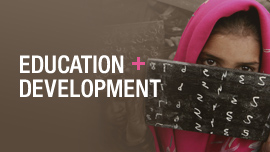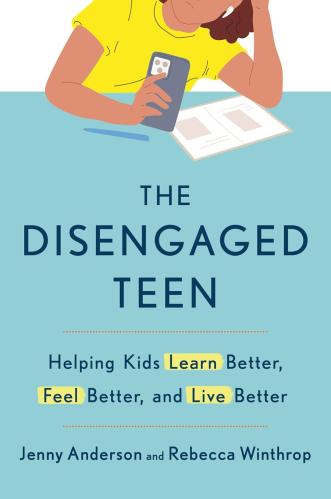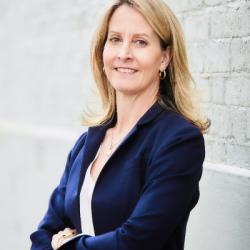As schools across the United States and around the world face persistently high levels of student disengagement and chronic absenteeism, Rebecca Winthrop and Jenny Anderson offer parents a new way of assessing their children’s engagement in school and highlight the importance of children having agency in their own learning.
Erin Thomas: Rebecca, you’ve worked for a number of years, both nationally and internationally, on education and child development issues. As senior fellow and director of the Center for Universal Education, you lead both the center and (along with fellow Emily Morris) the Family, School, and Community Engagement initiative. Additionally, you are a seasoned researcher and leader and a mom to two middle schoolers. Can you share a bit about what drew you to this work?
Rebecca Winthrop: My focus on the role of families and communities grew out of my work on education innovations. For years, I had been working with policymakers and practitioners to encourage the take-up of education innovations that help all young people develop the skills they need to thrive in today’s fast-changing world. I found in this journey that we in the education sector often overlook the important role of families as partners in transforming education. During the COVID-19 pandemic, this issue hit me in a much more personal way. When my two boys’ schools switched to home-based learning, I realized I had misjudged which of my children were deeply engaged in their learning. My oldest son, who had always gotten top grades and liked school, lost all motivation when his school went online and moved to “pass/fail” grading. Meanwhile, my youngest son, who had struggled in school because of his dyslexia, blossomed and was deeply engaged in learning on his own. I realized that if I wasn’t able to tell which of my kids was deeply engaged in school as a global education expert, it would be very difficult for most parents and caregivers too. I know grades only tell part of the story of how well our children are doing in school. I also know that in the U.S. parents and caregivers frequently resist and challenge education reforms. But this isn’t their fault. We in the education community don’t do enough to help parents and caregivers understand what good learning looks like. I was interested in helping fill this gap and I knew to do that storytelling would have to be an important part of the process.
ET: Jenny, you were a finance journalist for years and then shifted to education. Why did you make the change?
Jenny Anderson: My interests shifted after I had my first child in 2008. After spending more than 10 years immersed in financial reporting, I suddenly became curious about how learning happens—what is developmental, what is environmental, what is experience? I was immediately struck by how little the mainstream media covered these topics. There were good “mommy bloggers” gaining traction and a few trailblazing parenting journalists (Anna Quindlen and Lisa Belkin come to mind). But how kids learn and develop was not considered a beat worthy of an editorial desk staffed with seasoned reporters and editors. Is how humans grow and learn and thrive really less important or sophisticated than the stock market, or culture? A generous explanation might be that learning and development are so core to what it is to be human that we don’t think too much about how we, or our children, do it. A more realistic one is that care and nurturing of kids has long been deemed women’s work, so not serious enough to warrant the resources to cover it well.
I became more interested in finding new and creative ways to understand how humans learn and change. It’s hardly new: We had to adapt from farming to factories and factories to offices, to a second machine age and then a fourth industrial revolution. Now we have Generative AI. I was consumed with the question: If humans are born and wired to learn, how can we help our kids to do this well?
ET: You collaborated on a new book, “The Disengaged Teen: How to Help Kids Learn better, Feel Better, and Live Better,” out on January 7. Why is this the moment for this book?
RW: More than ever before, what kids need now is to become better at learning. Generative AI is accelerating rapidly, and everyone agrees that the pace of change will continue to be dizzying. Uncertainty is the new norm. No one knows exactly what shifts in jobs and society are in store. What can best protect and prepare our children is to help them become excellent at learning and adapting. This is incredibly hard to do if you are coasting through school, bored and checked out. According to the U.S. Census, only 1 in 3 students are engaged in school. CUE’s research with the nonprofit Transcend found that less than 10% of students had school experiences that regularly let them explore their ideas and interests and practice building their independent learning skills. Resilient learners are not strong; they are flexible. Learning well is also closely tied to feeling well. When children are deeply engaged in their learning, they not only perform better but have better mental health outcomes.
ET: Jenny, how does the book help parents and educators address the major challenges adolescents face today?
JA: Teens are deeply disengaged in learning and are reporting alarmingly high mental health challenges, as Rebecca mentioned. A lot of this is pinned on social media, but kids have been disengaged from learning far longer than smartphones have been hijacking our kids’ attention.
Adolescence is a period of staggering change, a period when brains are fundamentally reconstructed. It is a window of unique opportunity and vulnerability, when the stories young people tell themselves can become embedded in useful, and sometimes less useful, ways. How kids think about themselves as learners shapes the stories they tell, and as parents and educators we have influence to narrate and model one about growth, malleability, and possibility. During adolescence, parents can nudge their teens toward experiences and opportunities to help them understand who they are and who they hope to be. Grades and achieving are part of this; nurturing a robust learner identity—that is, developing what we call “Explorer muscles”—is both essential and overlooked. Becoming better learners will help kids accelerate toward goals they care about, unstoppable where they so often now seem stuck.
If COVID-19 showed us that kids need to be well to learn well, our research— and that of others—shows that kids also need to learn well to be well. The key to this is staying emotionally connected to teens, but then having better language to understand and talk about their learning.
ET: In the book, you develop the Four Modes of Engagement framework, which is intended to help parents and educators identify how students engage in school. Can you talk a bit about the framework and how it provides a new perspective on students’ learning and engagement?
RW: How deeply children engage in their learning shapes not only how they do in school but also the learning skills that they develop. When students are more engaged, they are more likely to attend school, have good grades, master content, graduate, and have prosocial behavior. The problem is that it can be quite hard for adults to accurately assess how deeply engaged their children are. Adults are good at understanding the behavioral dimensions of engagement in school, like attending class, not being disruptive, and turning in homework. They aren’t as good at assessing the emotional and cognitive dimensions of engagement, like being interested in what they are doing, feeling like they belong in school, and thinking deeply about what they are learning. In our research, we found that a student’s grades do not always reflect how engaged they are in their learning. Many students are disengaged but able to get good grades usually because the material is not sufficiently challenging.
It is hard to address a problem you cannot fully see. This is why we developed the four modes of engagement, to help parents and caregivers but also educators better assess and address their children’s level of engagement. Our research showed that young people engage in four main ways with school and learning:
- Resister mode. When kids resist, they struggle silently with profound feelings of inadequacy or invisibility, which they communicate by ignoring homework, playing sick, skipping class, or acting out.
- Passenger mode.When kids coast along, consistently doing the bare minimum and complaining that classes are pointless. They need help connecting school to their skills, interests, or learning needs.
- Achiever mode. When kids show up, do the work, and get consistently high grades, their self-worth can become tied to high performance. Their disengagement is invisible, fueling a fear of failure and putting them at risk for mental health challenges.
- Explorer mode. When kids are driven by internal curiosity rather than just external expectations, they investigate the questions they care about and persist to achieve their goals.
Students can move between all these modes in the course of a day, depending on their teachers, classes, or peers. Often, however, kids are in one mode in school but in another one after school.
ET: Jenny, how can parents and educators use this framework to help improve student engagement?
JA: They can use this framework in three ways. First, the modes can be used to identify where kids are, which enables adults to offer better support. Kids in Passenger mode often need more autonomy whereas kids in Resister mode might need us in the trenches with them problem solving. Kids in Achiever mode may look like they are hitting it out of the park, but they need more opportunities to take risks on behalf of their learning. The modes help us understand their learning and in time can be used by young people themselves to understand the choices they make on behalf of their learning.
Second, the framework can help adults support kids who get stuck in Resister, Passenger, or even Achiever mode to get out. These modes are dynamic and fluid, but when kids become entrenched in one, it can become an identity. Our goal is to help young people build self-awareness and regulation strategies. The modes are one way to understand what’s happening and to better identify when things are going off the rails. Disengagement does not happen overnight—it is gradual. We want to intervene earlier in the engagement continuum, before we hit a crisis point.
We hope parents and educators help kids spend as much time in Explorer mode as possible. The research with Transcend showed that only 33% of 10th graders report that they get to develop their own ideas in school. This can lead to real disengagement.
ET: Rebecca, one of the center’s workstreams is focused on youth agency. Can you define that and explain how it relates to the book?
RW: Agency is the ability to set meaningful goals and marshal resources to meet them. It isn’t just having a plan, it’s being able to design and execute that plan, even if it means overcoming barriers along the way. It requires tapping into internal resources, like effort, but also asking for help from external ones like teachers, parents, neighbors, pastors, peers, or a chatbot.
We know young people need agency, particularly to navigate the world that is to come. With generative AI able to synthesize knowledge to answer questions, students need to develop skills to ask the questions that matter to them, come up with creative new solutions, and harness resources, be they technological or human, to help them deliver on their vision.
When students are in Explorer mode, they are “agentically engaged” in their learning. This means they are constructively influencing the flow of instruction to be more supportive and interesting to them. They are proactive, asking to work on topics that interest them, suggesting different ways to learn, and taking opportunities to reflect on what they’re interested in. In school, too few students get the chance to regularly be in Explorer mode. But they should. After all, school is one of the important places where young people can learn to develop agency over their learning, an essential skill for all stages of life.
This is what we are working toward at CUE, and it’s also how we hope our book can help. We want to help parents, caregivers, and educators today support their children to have more Explorer moments at home and in class. We also want to invite families into the movement to change the design of the schools of tomorrow and make Explorer mode the default, not the exception.
The Brookings Institution is committed to quality, independence, and impact.
We are supported by a diverse array of funders. In line with our values and policies, each Brookings publication represents the sole views of its author(s).







Commentary
Coaching kids to be better learners: An interview with Rebecca Winthrop and Jenny Anderson
January 6, 2025